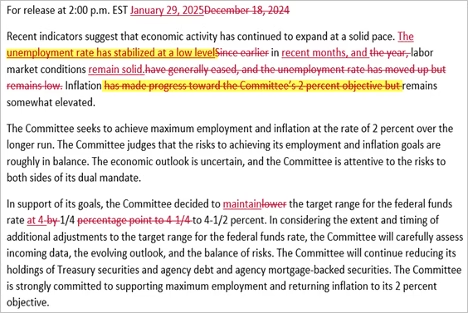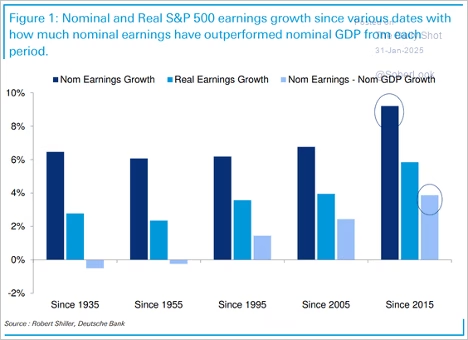Despite restricted access to advanced chips, China’s latest AI advancement, DeepSeek, surprised the markets. This progress could present challenges for NVIDIA and other US tech firms.
 Source: BI Read full article
Source: BI Read full article
Source: Reuters Read full article
DeepSeek vs. OpenAI:

US fracking activity continues to deteriorate. Saudi oil exports have been trending lower.
Economy:
The Conference Board’s consumer sentiment indicator declined again this month. The labor differential index declined, indicating that Americans see fewer job opportunities. Purchase intentions for homes and vehicles declined sharply. Fewer consumers expect to take a vacation. Durable goods orders fell in December, driven by weak aircraft orders. However, excluding transportation, orders increased, with capital goods orders exceeding expectations. The Richmond Fed’s regional report indicated that the manufacturing downturn eased this month. Factories started hiring. More companies are boosting wages. The regional Fed reports point to a sharp rebound in factory activity at the national level (ISM) in January. Home prices continued to rise in November.
The US trade deficit in goods reached a record high as importers rushed to front-run tariffs while exports weakened. The record goods trade deficit and the unexpected inventory decline drove the Atlanta Fed’s GDPNow Q4 growth estimate sharply lower, from 3.1% to 2.3%. US Q4 GDP growth was below expectations but aligned with the Atlanta Fed’s GDPNow estimate at 2.3%. Consumer spending accelerated, driven by households rushing to front-run tariffs. Business investment weighed on Q4 GDP growth, as Boeing strike disruptions impacted business equipment spending. After two consecutive quarterly declines, housing investment rebounded. Surprisingly, net exports contributed positively to growth. Domestic demand growth remained robust. The stock market is pricing in a sharp rebound in US factory activity. Without seasonal adjustments, pending home sales dropped to their lowest level since the National Association of REALTORS began reporting the index in 2001. Rising mortgage rates suggest ongoing weakness in pending home sales, which, in turn, signals softness in existing home sales. US nominal earnings growth has outperformed nominal GDP growth since the 1990s.
Source: Deutsche Bank Research
The Fed:
As expected, the FOMC held rates steady this month. The Fed sees the labor market as robust, with unemployment stabilizing “at a low level.” Additionally, the FOMC removed language about progress toward the 2% inflation target, signaling concerns about upside inflation risks.


Economists and the market anticipate two Fed rate cuts this year.
DeepSeek – What We Know So Far
China’s DeepSeek AI model rocked current thinking due to its innovative approach and potential advantages over existing large language models (LLMs) developed in the U.S. Several key distinctions make DeepSeek unique, particularly its cost-efficiency, resource utilization, open-source nature, and performance. These characteristics present opportunities and challenges for the broader AI industry, especially for companies supplying technology to AI developers.
One of the most striking differences is DeepSeek’s cost-effective development. Unlike U.S. models like OpenAI’s GPT-4, which require substantial financial resources—often hundreds of millions of dollars—DeepSeek’s R1 model was developed in just two months with an investment of under $6 million. This lean approach demonstrates that high performance can be achieved without the massive budgets typically associated with cutting-edge AI. DeepSeek’s innovative training methods allow it to operate effectively with less advanced hardware, unlike U.S. models that often depend on high-performance computing resources. This resource optimization reduces barriers to entry and makes advanced AI capabilities more accessible.
DeepSeek’s open-source nature also sets it apart. By releasing its code openly, the model fosters collaboration and global contributions, enabling developers worldwide to adapt and improve upon it. On the other hand, U.S. LLMs are often proprietary, restricting access to their underlying code and limiting external innovation. Despite these differences in approach, DeepSeek delivers comparable performance to U.S. models in areas like problem-solving, programming, and natural language inference, challenging the notion that high costs and proprietary systems are prerequisites for success in AI development.
The rise of DeepSeek presents significant implications for companies supplying AI developers with technology. The risk is that its efficiency and cost-effectiveness could reduce the demand for high-performance computing hardware, impacting suppliers specializing in this area. Furthermore, its success as an open-source model may shift the industry toward open-source AI development, reducing the proprietary software and support services market. This shift could also pressure existing AI developers to lower their operational costs, leading to a demand for more affordable hardware and software solutions. Suppliers may need to innovate and focus on products that support efficient AI training and deployment to remain competitive.
However, for all the potential negatives, introducing competition could also be an enormous benefit.
The Bullish Case Of Competition
As such, DeepSeek could reinvigorate the global push for technological leadership. For U.S. companies like Nvidia, Google, and Microsoft, this could be a positive catalyst in several ways:
- Accelerated Innovation: Just as the U.S. ramped up its investment in space technologies after Sputnik, companies like Google and Microsoft may significantly increase their R&D spending to maintain their competitive edge in AI. This could lead to the development of more advanced models, better algorithms, and new use cases for AI across industries.
- Demand for High-Performance Hardware: Companies like Nvidia, a leader in GPUs and AI hardware, stand to benefit from the heightened competition. Advanced AI models require powerful computing infrastructure, and Nvidia’s products are essential for training and deploying these models. If the competition intensifies, demand for Nvidia’s hardware could rise significantly.
- Expansion of AI Applications: The competitive push could accelerate the adoption of AI in various sectors, from healthcare and finance to autonomous vehicles and education. This would benefit companies like Google and Microsoft, which provide cloud platforms and AI tools to support these applications.
- Increased Government and Private Sector Funding: As seen during the Space Race, heightened competition often spurs increased investment from both governments and the private sector. Governments may allocate more funding for AI research and development, while private companies may double down on their AI initiatives to maintain relevance in a rapidly evolving market.
- Broader Economic Benefits: A surge in AI innovation could lead to productivity gains across industries, boosting economic growth. The ripple effects of AI advancements could create jobs, transform industries, and enhance the quality of life, much like the technological spin-offs from the Space Race.
With markets still trying to figure out what DeepSeek just did, this long analysis asks about the elephant in the room. If AI can really been done at such lower cost, why didn’t OpenAI and other US companies already do it? The surprising answer: they didn’t want to. The idea that AI had to be expensive was their competitive moat.
Key Points:
- The DeepSeek platform is effectively free. Its code is open source and any company can use it to make their own AI products.
- This undermines the economics of big generative AI companies like OpenAI and Anthropic.
- The AI bubble was premised on the idea these models were impossible to build without spending massive amounts of cash.
- With a US company planning to put DeepSeek’s model online, we will soon know for certain if it outcompetes the bigger players.
- US players could have easily done the same thing, but didn’t because it would have invited competition.
The DeepSeek story isn’t really about China, it’s about giant problems in the US tech industry. To us, it also looks like a perverse residue of the ZIRP era. When capital is artificially cheap or even free, the incentive to use it efficiently disappears.
However, DeepSeek claims to use Nvidia’s less-performing H-800s GPU chips. Experts say they were able to train the AI language models more efficiently. Think of DeepSeek models and possibly others, learning from the open-source nature of OpenAI and doing it more efficiently at a fraction of the costs. While competition is excellent and quickens innovation, the concern here is China and the fact that the government owns every Chinese company. If we are worried about TikTok and how our personal data is being collected and used by the Chinese government, what about DeepSeek? That’s TikTok risk on steroids.
Italy has already banned the app due to privacy concerns, and today, NASA became the latest federal agency to block China’s DeepSeek on security concerns. China doesn’t play by the same IP rules we adhere to. I kept wondering if they backed doored access to the chips and grabbed the code from OpenAI.
Shark Tank’s Kevin O’Leary speculates that DeepSeek likely obtained cheaper NVIDIA chips through some “black market trade,” though he acknowledges he’s not sure how they acquired the hardware. As for data privacy concerns, O’Leary is worried about them. He says that if you install the DeepSeek app and read the agreement, they are clearly scraping user data like emails. O’Leary believes this is an attempt by China to keep scraping American data, even if TikTok gets banned. He views it as part of China’s broader AI and data war against the US.
Great Quotes
“February, winter’s embrace,
Shortest month, delicate grace,
Hearts and snowflakes gently fall,
February, quiet midst the sprawl,
Hints of spring beneath the snow,
Valentine’s and candlelight’s glow,
Leap years dance on rare delight,
A month of subtle, muted might.”
– ClaudeAI, with Steve Blumenthal’s guidance
Picture of the Week
Dolomite mountains, northern Italy

All content is the opinion of Brian Decker








